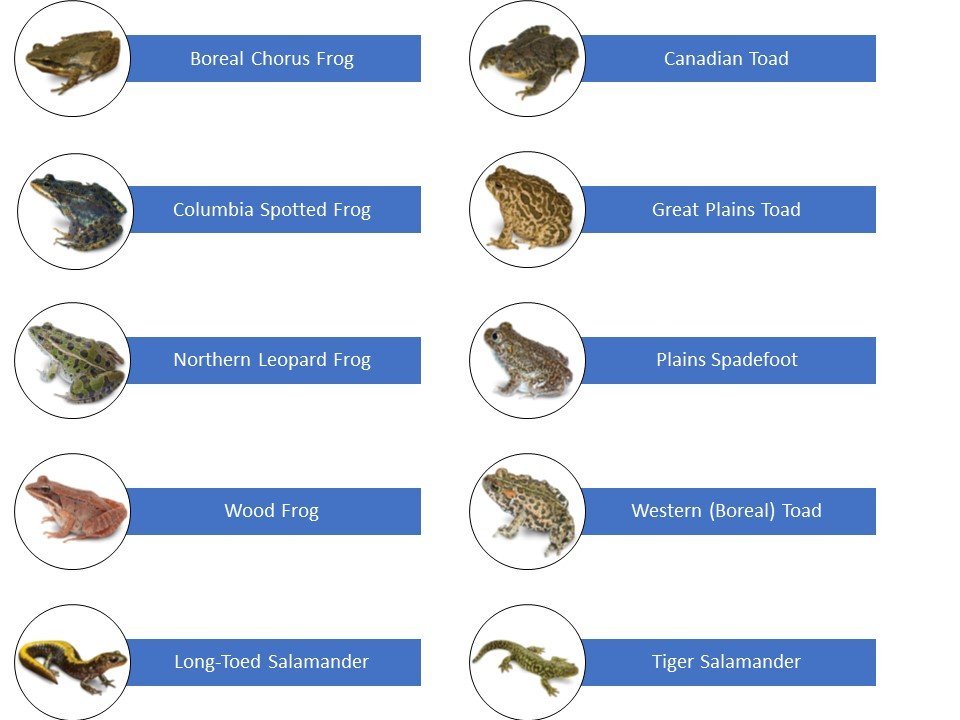Who’s Who in That Pool?
Exploring Alberta's Amphibian Species
As spring sweeps into Alberta, ice thaws, snow melts away, and seasonal rains and flurries fall, all across the province waterbodies fill and wetlands come to life. Many of us will turn our eyes skyward watching flocks of birds wing their way north from their winter refuges, but from under the fallen leaves, rocks, holes, and mud, another migration is happening. An armada of small bodies, some with smooth skin, others knobbed and bumpy, push their way to the surface and make small steps on big journeys to their watering holes.
With the exception of salamanders, anurans (frogs and toads) are born with an innate vocal repertoire, each species has its own advertisement calls. As small animals in a big world, these calls are the best way to attract and locate a mate. The structure of the calls, the pitch, and the intensity all contribute to how females respond to males. The better the call, the better the chance of coupling up. In Alberta our frog species can be heard calling throughout the spring, but toad species, particularly those in our arid regions, may call well into summer if rains do not fall. Plains spadefoot and Great Plains toad may delay or forego breeding at all if their ephemeral wetlands or ponds don’t fill.
Figure 1. Greater proportions of Y-sperm were produced in males that were raised with high male density (A) compared to males raised with high female density (B). An increasing proportion of Y-sperm was produced as the proportion of males in their litter increased (A and B). The litter sex ratio indicates what percentage of the litter was male; a low litter sex ratio (0.3) indicates a high proportion of sisters and a litter sex ratio of 1.0 means the male had only brothers.
The calls of amphibians are important to their biology and successful breeding, and evolving research has found that human-made noises pose a threat to amphibians as they change aspects of their calls to compete with human noise, leading them to be less successful in finding mates. Wildlife biologists, like those at AJM, use the timing of amphibian breeding to go out at night and survey for these elusive species. Follow this link to access a sound library to search amphibian and other wildlife sounds https://www.macaulaylibrary.org/.
Once a mate has been found, male frogs and toads wrap their front arms around a female in “amplexus” a term used to describe the pose. Males can be so tenacious that the males from some species may stay in this position for weeks. With her male backpack attached, the female begins to lay eggs, the male fertilizing them each as they emerge, and the protective jelly swelling up almost immediately. In the case of salamanders, males deposit small packets of sperm that the females pick up and use to fertilize her eggs internally. The structure of amphibian eggs and the way in which they are deposited into a wetland tells us a lot. Toads lay their eggs in long strands, draped across the bottom of wetlands, laying over submerged rocks and twining through vegetation. Frogs lay their eggs in clusters called egg masses whose size, shape, and placement vary by species. Salamanders, prefer smaller packages, laying small clusters of eggs or depositing eggs singularly, attaching them to vegetation. Salamanders also offer their eggs extra protection, double wrapping them in thick protective jelly allowing aquatic predators to eat away the outer jelly layer while the jelly protecting the egg stays intact and the larvae inside develops. Frogs and toad eggs only have one layer of jelly, as they prefer playing a numbers game, overwhelming predators with the sheer number of eggs laid in the same place at the same time.
As eggs develop, the amphibian larvae, or tadpoles, can be seen in their stages of development through the clear jelly. Some species develop very quickly, plains spadefoot eggs and tadpoles mature in a matter of weeks as they make a mad dash to beat the quick evaporation of the prairie puddles, they breed in. In most cases, eggs hatch in a matter of weeks and tadpoles take weeks to develop the limbs they need to leave the water. Salamander larvae emerge with external gills that look like frilly adornments on the sides of their head. As tadpoles mature, their tails shrink as they are reabsorbed to give them the fuel they need to grow limbs. Salamanders may stay as larvae for years as they grow large enough to shed their gills and emerge on land. Some salamander larvae, never leave, and stay their entire lives as gilled, aquatic, predators, affectionately dubbed “mud-puppies”. As with amphibian eggs, tadpoles and larvae bear individual characteristics that identify them by species. In general, frog tadpoles have eyes placed more on the sides of their head while toad tadpoles sport eyes that rest higher on top of their heads. Toad tadpole tails often have very wide tail fins with heavier musculature. Frog tadpoles may have finer and longer tails. The placement of eyes, spiracles that they use to breathe underwater, the color of their mouths, coloration, and tail size can all be used to tell them apart. Salamander larvae often resemble their adult forms but their color and the appearance of their gills are features that help with identification.
Amphibians are sensitive species and charismatic inhabitants of our wetlands, prairies, and forests. Their skin, young, and eggs are extremely sensitive to the conditions around them. They are indicators of ecosystem health and by keeping amphibians safe we can ensure wetlands and waterbodies are kept in a condition that support fish, wildlife, and are safe for human recreation. They should not be handled as our skin can transfer harmful chemicals, and it takes experience to effectively count and move them in cases of emergency. AJM surveys wetlands to detect and identify these species and perform permitted salvages of amphibians when there are threats to ensure they are protected. Our goal is to ensure they can emerge each year to make their ponderous journeys back to the pools they emerged from for years to come. We hope you get out this spring to explore the wet places in your neighborhood, don’t be afraid to jump in and join the party and get to know the whose who at the pool this spring.
By: Miriam Boucher MSc., P.Biol., R.P.Bio., Environmental Scientist







